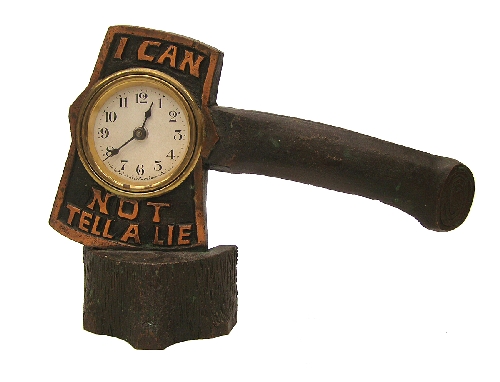Value of unique items often difficult to find

Sometimes it is impossible to find another collectible just like yours, so how can you learn what yours is worth?
While checking Internet auctions, I came across a strange cast-iron clock shaped like a hatchet stuck in a block of wood. The clock face was in the center of the hatchet blade surrounded by the words “I can not tell a lie.” I knew the clock had to be about George Washington, who, legend says, admitted to his father that he chopped down a cherry tree. That story is probably a myth, made up after Washington’s death in 1799 to impress children with the honesty of the father of our country.
Could the clock have been made for the 1889 Centennial Celebration in Chicago that celebrated the 100-year anniversary of the inauguration of George Washington? Or could it be from some other fair or celebration that had souvenir hatchets that honored Washington. The clock is not listed in any price books.
Copake Auctions of Copake, N.Y., recently offered it at auction. Copake probably looked at values of other figural clocks, then considered current interest in George Washington and the decorative value of the clock. The auction suggested the clock might be bought for about $250. It sold for $113. That’s often what happens with unusual items at an auction.
There is a saying that anything that moves or makes noise gets good prices. This clock did neither and wasn’t beautiful or terribly old. It’s just very unusual. High prices come from bidding competition, and the hatchet clock had few bidders to push up the price.
Q: My two-tiered table was made by the Imperial Furniture Co. of Grand Rapids, Mich. It has claw-foot legs and scalloped edges. Can you tell me anything about it?
A: The Imperial Furniture Co. was founded by Stuart Foote in Grand Rapids in 1903. It was bought by Bergsma Bros. in 1955, after Mr. Foote died. The company made several different kinds of tables, desks, tea carts and other furniture.
It’s not possible to date your table without knowing how it is marked. Pieces made between 1910 and 1917 were marked with an oval logo, while later pieces have a shield-shaped logo.
Q: I own an Ives O-gauge clockwork toy train set that was found under the eaves of a cabin on Donner Summit about a half-mile from where the Donner Party crossed the summit at 8,000 feet. The cabin was constructed of timbers 14 inches square left over from train sheds constructed by Chinese workers in about 1900. We bought the cabin from the original builder, and I think the train set was a gift he had given his son.
The four train cars and track are in their original box. I don’t think the train was ever played with. The cast-iron cars in the set are a No. 17 engine and tender, No. 551 chair car and No. 550 baggage car. What do you think of the set?
A: Your cabin has an interesting history, and any Ives train set is worth some money. Based on the car numbers you gave us, the set was made between 1917 and 1930. Dating it more specifically would help you estimate a value. In general, the older the better.
Ives Manufacturing Corp. traced its history back to 1868, when Edward Ives founded a toy company in Bridgeport, Conn. The company didn’t start making trains that ran on tracks until after 1900, when it rebuilt and retooled its machinery after a fire. Lionel became a big competitor starting in 1913 and forced Ives into bankruptcy in 1928. After that, the Ives lines were taken over by Lionel and American Flyer only for a few years.
Tip: To clean the residue left by cigarette smoke, use a damp good-quality microfiber cleaning cloth. A Mr. Clean pad also might work on ceramics or glass.
Terry Kovel’s column is syndicated by King Features. Write to: Kovels, (Las Vegas Review-Journal), King Features Syndicate, 300 W. 57th St., New York, NY 10019.












